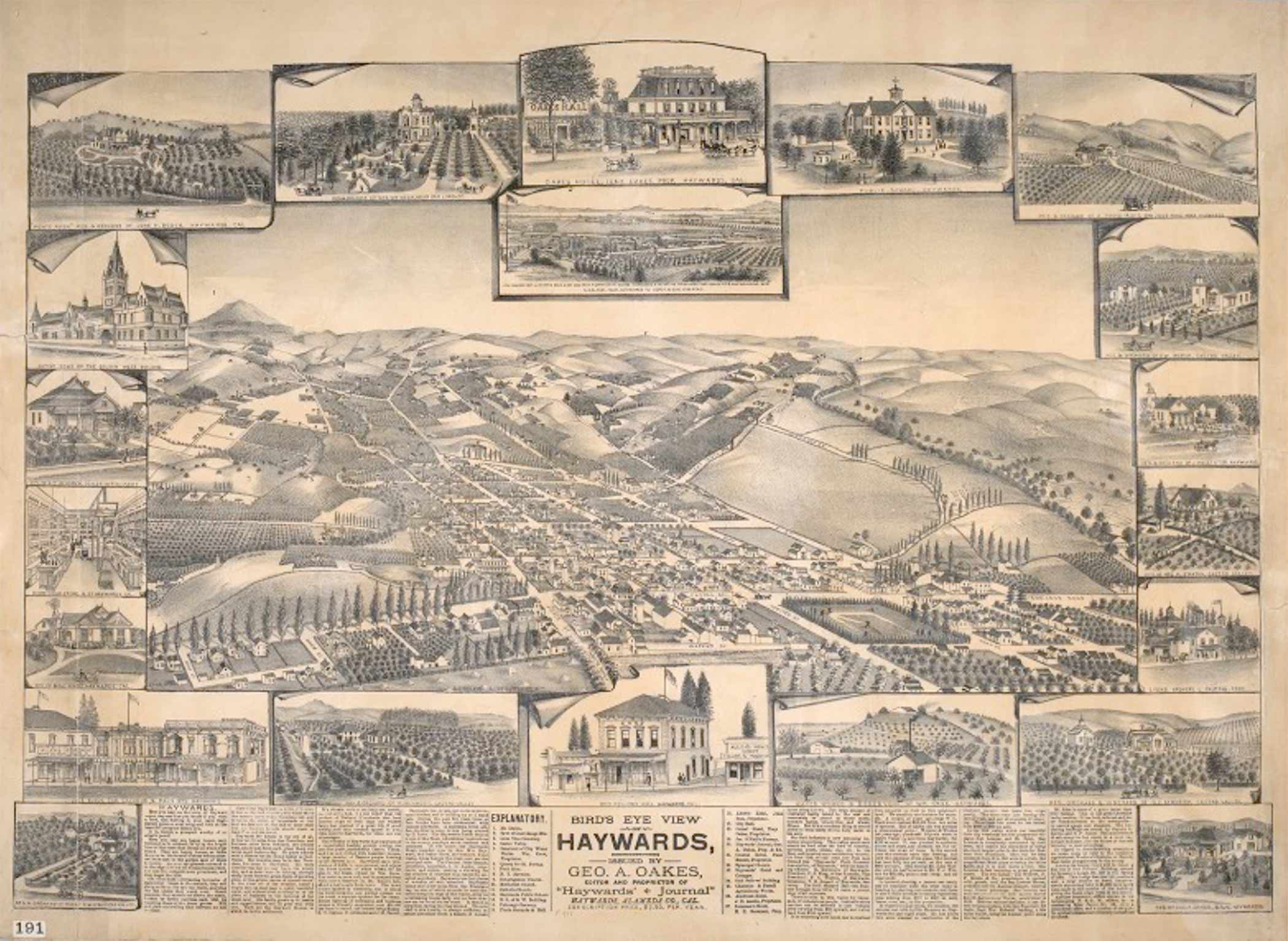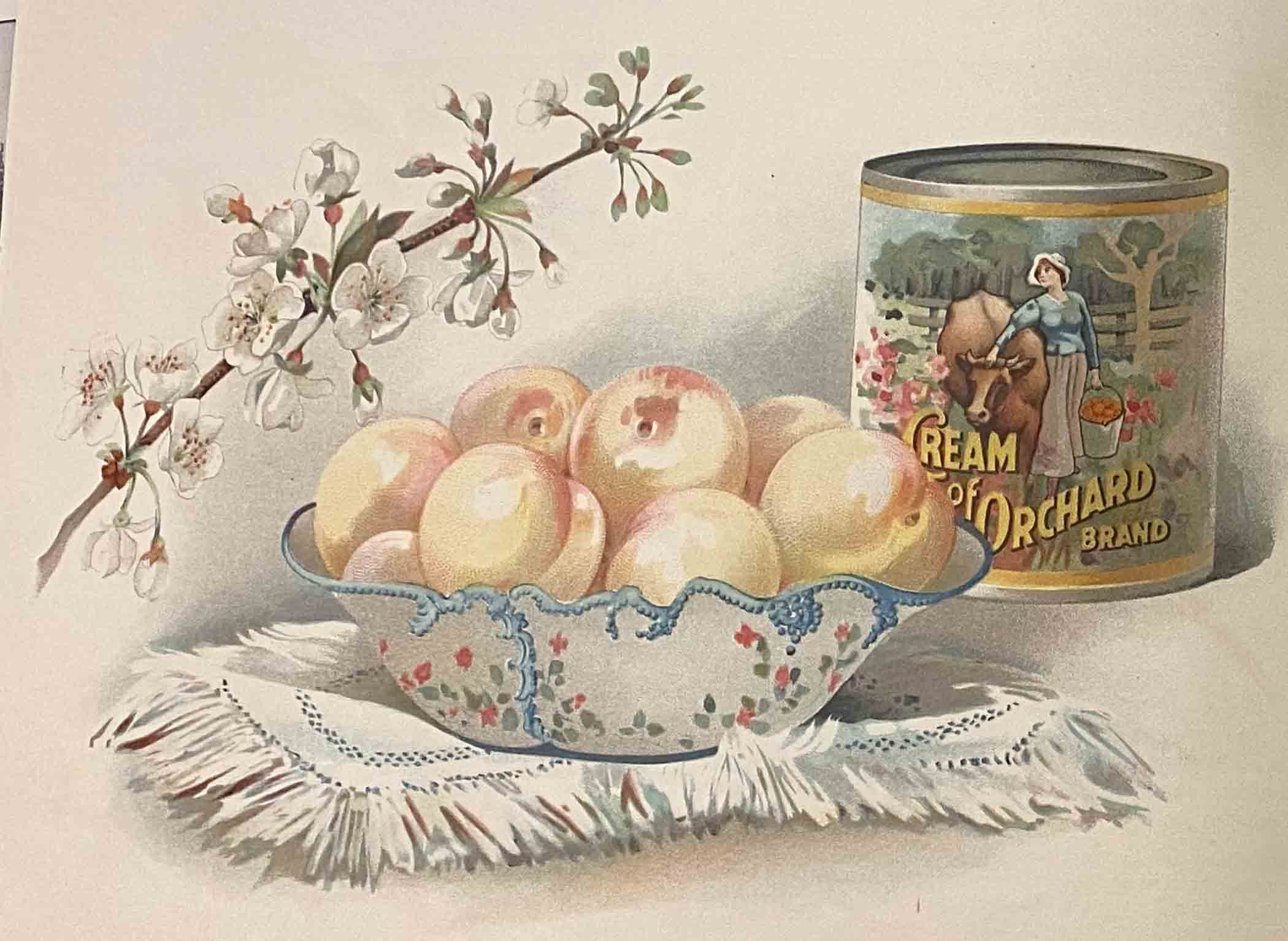EDEN
The Erasure & Eden exhibit explores the allure of Hayward through photographs, promotional materials, and postcards published from the 1890s to the 1960s. Using chronology, the viewer will come to understand how Hayward transformed from a rural town into an urban city with promises of paradise and prosperity. Additionally, this exhibit will demonstrate how the perception and design of homes were as diverse as those who settled here.
“If a climate such as not Italy can match, has any attraction, if a soil richer than the polders of Holland, if the orchards that bear heavier crops of fruit than the wildest fancy has planted, if a quiet life, if good society, and very comfort appeal to you, then come to Haywards, for these are our advantages.”
This late 19th century lithograph, Bird’s Eye View of Haywards, was published as a promotional piece for the City of Hayward by the local newspaper, Hayward’s Journal. In this advertisement, the city’s promoters constructed a captivating dream of affordable, serene, healthy country living that offered modern amenities and high society culture. Equally alluring for the potential homebuyer was the promised prosperity that could be found in lucrative agriculture, ranching, industrial, and salt production ventures within Hayward. City promoters aimed to stimulate economic growth and increase the population beyond the 1,400 town residents.1

This colored panoramic photograph captures rural Hayward in the 1910s, which at this time had a population of 2,746. Written above and below the structures are references to landmarks the previous owner deemed important. From left to right, “(unreadable) Hotel,” “Native Son’s Hall,” “Grammar School, “Danish Hall,” “my home,” “Catolic (Catholic) Church,” and “Base Ball Ground.” During this period, Hayward was predominately an agricultural town with homes that ranged from small cottages to larger Victorian houses. In the photo, barns, carriage houses, churches, schools, and community structures are situated amongst the homes.2
To draw attention to the city of Hayward and its surrounding vicinity, the Souvenir Magazine of Hayward (circa 1905) was created. The publication depicts Hayward as the “Garden of Eden,” proclaiming it as “near prefect as the hand of Providence can make it.” Within its pages, the author poetically describes Hayward’s rich natural resources, favorable geographical location, and mediterranean climate. The town’s many attractions, such as the “best farming, fruit growing, stock raising, and residential sections,” are detailed within the magazine’s pages. Photographs of the town’s beautiful homes and land, businesses, civic and religious structures, and wealthy businessmen and politicians are displayed. The promoters of Hayward hoped to attract entrepreneurs and an economically diverse population to the “land of sunshine, where flowers blossom in the open all year round.” 3


Citations
1 Cook, C. B. Bird’s-eye view of Haywards [Hayward, California]. Circa 1880-1890. Lithograph. Elliott Pub. Co. Accessed from OAC. Bird’s-eye view of Haywards [Hayward, California] BANC PIC 1963.002:0927–E (cdlib.org)
2 Panorama of Hayward, Ca. Photo. 1910s. Accessed from AlamedaInfo. Hayward, California, old postcards, photos and other historic images – Alamedainfo
3 “Garden of Eden Hayward, California.” Souvenir Magazine. 1905. Hayward Review: Hayward, CA. Accessed from Hayward Area Historical Society. Resources for Researchers — Hayward Area Historical Society (haywardareahistory.org).
4 Group in an Orchard. 1906. Catalog 2011.008.067. Glass Plate Negative. Advanced Search | Hayward Area Historical Society (pastperfectonline.com)
Woman on the Phone. 1948. Catalog 2019.014.0070. Negative. Advanced Search | Hayward Area Historical Society (pastperfectonline.com)
Man Seated at Desk. 1948. Catalog 2019.014.0245. Negative.Advanced Search | Hayward Area Historical Society (pastperfectonline.com)
Black and white photograph of a dairy. 1948. Catalog 79.033.8893. Print. Advanced Search | Hayward Area Historical Society (pastperfectonline.com)
Sorting Peas. 1925. Catalog 79.033.7618. Print. Advanced Search | Hayward Area Historical Society (pastperfectonline.com)
Auto Mechanic. 1948. Catalog 2019.014.0352. Negative. Advanced Search | Hayward Area Historical Society (pastperfectonline.com)
Butcher Shop. 1948. Catalog 2019.014.0257. Negative. Advanced Search | Hayward Area Historical Society (pastperfectonline.com)
5 Fruits of the Garden of Eden, Hayward, Garden Spot Eden Township. No. 7516. M. Rieder Publishing: Los Angeles, CA.
6 Hunts operations and advertising docs. Sourced from the Hayward Historical Society.
7 Hayward Alameda County, California, U.S.A. 1939. Hayward City Council and Chamber of Commerce. Accessed from Hayward Area Historical Society. Resources for Researchers — Hayward Area Historical Society (haywardareahistory.org).
8 Hayward, California and Vicinity. 1932. Hayward City Council and Chamber of Commerce. Accessed from Hayward Area Historical Society. Resources for Researchers — Hayward Area Historical Society (haywardareahistory.org).
9 Palma Ceia Village – Sourced from Hayward Historical Society.
10 Agricultural History — Hayward Area Historical Society (haywardareahistory.org)
11 Hayward Alameda County, California, U.S.A. 1939. Hayward City Council and Chamber of Commerce. Accessed from Hayward Area Historical Society. Resources for Researchers — Hayward Area Historical Society (haywardareahistory.org).



























